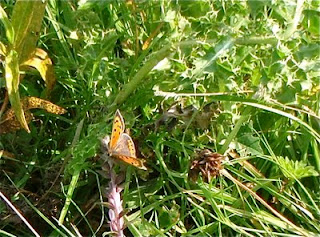Boldings Brook is a fine example of a Wealden stream, with its sources to the north of Horsham, (West Sussex), in Surrey, where water from the Surrey Hills (subject to very heavy rainfall at times) drains into the valley and the stream, now in Sussex, meanders through meadows often flooded in winter and enters Warnham Millpond. Chennels Brook to the east enters the Millpond nearby. Boldings Brook leaves the Millpond via sluice gates to the south and flows, with steep-sided, wooded banks with some very fine old oaks and diverse thickets forming a rich wildlife corridor, to join the River Arun at a meandering confluence.
Boldings Brook in summer, clear running water with some muddy banks popular with birds and plenty of river bank vegetation to provide shelter.
A large Spindle tree full of fruits in a thicket with Blackthorn, Hawthorn, Hazel, Dog Rose, Ash and Oak at the confluence of Boldings Brook and the River Arun, a superb mixture of Riparian vegetation supporting a large number of species, some common and some scarce.
YESTERDAY 28th September 2011 on a walk along Boldings Brook and the Arun at Hills Farm Lane (our area) the following species were recorded:
robin (24), woodpigeon (20+), carrion crow (3), blue tit (33, great tit (18), nuthatch (6) , song thrush (1), willow warber (1), chiffchaff (4), greenfinch (12), treecreeper (1), jackdaw (2), goldfinch (12), blackbird (9), chaffinch (4), wren (9), grey wagtail (1), magpie (2), linnet (1), house sparrow (16), herring gull (11), great spotted woodpecker (1), long-tailed tit (2+), bullfinch (1), green woodpecker (1), jay (1), kingfisher (1), reed bunting (1), buzzard (1). Butterflies: Red Admiral (4), Speckled Wood (8), Large White (3) and millions of spiders casting their long webs across trees, thousands fo Craneflies low over the river banks and grass.




